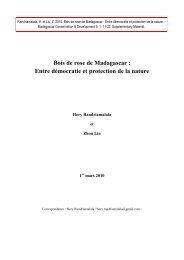Journal Madagascar Conservation - Madagascar Wildlife ...
Journal Madagascar Conservation - Madagascar Wildlife ...
Journal Madagascar Conservation - Madagascar Wildlife ...
You also want an ePaper? Increase the reach of your titles
YUMPU automatically turns print PDFs into web optimized ePapers that Google loves.
MADAGASCAR CONSERVATION & DEVELOPMENT VOLUME 3 | ISSUE 1 — DECEMBER 2008 PAGE 10<br />
FIGURE 2. Map of Manambolomaty Lakes showing GELOSE resource management delimitation for FIZAMI and FIFAMA Associations in western <strong>Madagascar</strong>.<br />
of the Tompondranos the main taboos regarding the use of lakes<br />
during the day of the opening fishing season.<br />
The night prior to the official opening fishing season, local<br />
communities were overnighting under the one tamarind tree<br />
(Tamarindus indica Fabaceae) at the sacred site along the lake-<br />
shore. This tree has high spiritual value for Sakalava tribe. All<br />
night, they were singing traditional songs instrumented with<br />
traditional drums to excite the ancestors to attend and honor<br />
the opening fishing season ceremony the following day. This<br />
procedure continued until the ceremony was over about 13<br />
hours later. The actual opening season begins in morning from<br />
1000h-1100h. It is believed by the Sakalava people that this<br />
mid - morning time is the best period for the ancestral blessing.<br />
One sub - adult female of back - colored Tompondrano’s zebu<br />
– with a white spot (about hand - size) in its front side and white<br />
tipped tail – was sacrified for expressing obedience towards<br />
the ancestors. The zebu’s blood was drunken by ancestral spirit<br />
staying in Tompondrano family to express the continuity of life<br />
between today’s generation and their ancestors. The meat taken<br />
from zebu’s hump, heart, offal, and a black banana (rare variety<br />
of banana in the area) – that are considered as valuable food<br />
– were cooked without salt as a gift to the ancestors. Sakalava<br />
people believed that salt brought the bad luck into their life.<br />
These foods and drinks composed of honey (symbolizes a high<br />
respect toward the ancestors) and water were then dropped<br />
from a dugout canoe into specific corners of the lakes (three<br />
for Soamalipo / Befotaka and one for Ankerika) for the ancestors.<br />
Normally, ancestral servers included men and women<br />
wearing lambahoany (Malagasy cotton sheets) and women had<br />
their hair pleated in the Sakalava style. Once these groups of<br />
servers returned to festivity place, several groups of fishermen<br />
began fishing to mark the start time of the fishing season.<br />
Ancestral satisfaction was reflected by the number of persons<br />
within the Tompondrano family where the spirits of ancestors<br />
entered into them during the ceremony. Notably, these persons<br />
with ancestral spirit behaved differently than during their daily<br />
routine behaviors. The captured fish from these first groups of<br />
fishermen and the remaining zebu meat were shared among the<br />
community to receive benediction from the ancestors – and this<br />
marked the end of ceremony. All Tompondrano expenses for the<br />
opening fishing season ceremony were reimbursed from the sell<br />
of fishing permits at the end of fishing season.<br />
CONSERVATION IMPLICATIONS Fishermen and fishing<br />
yields. The annual regulations of fishermen, fish yields, and<br />
the fishing season in the Manambolomaty Lakes have been<br />
recorded from 2002 to 2007 (Table 2). The number of fishermen<br />
working in the Manambolomaty Lakes has never exceeded the<br />
annual conventional quota of 400 persons. The annual fishing<br />
season opens in June for FIZAMI and most recently – in August<br />
2005 and August 2006 – for FIFAMA when the Tompondrano<br />
(keeper of the lake) passed away during January 2005. From 2002<br />
to 2004, fish yields were stable at 89 - 116 tons, and then they<br />
dropped to 34 tons in 2005. The long time spent for the process<br />
of Tompondrano replacement affected the FIFAMA Association<br />
functioning during this later year. In 2006 they increased to 67<br />
tons and by 2007 were up to 200 tons.<br />
FISH AND TREE HARVESTING METHODS None of the<br />
fishermen who are using the conventional net size (100 m x<br />
1 m) and mesh width of three fingers are using salt to preserve<br />
fish. Annual average of 1 - 5 poachers were caught using long



